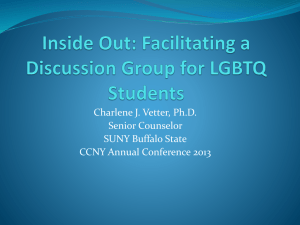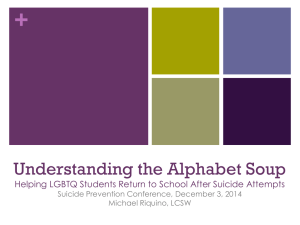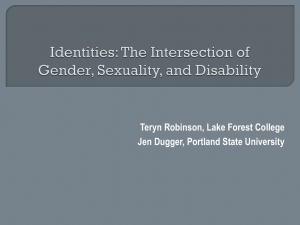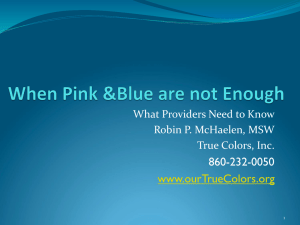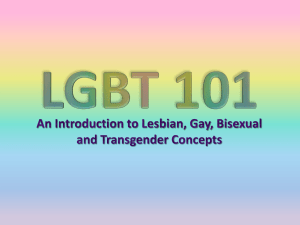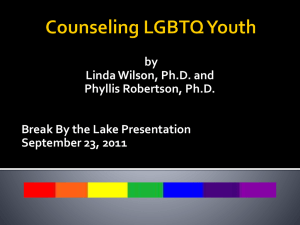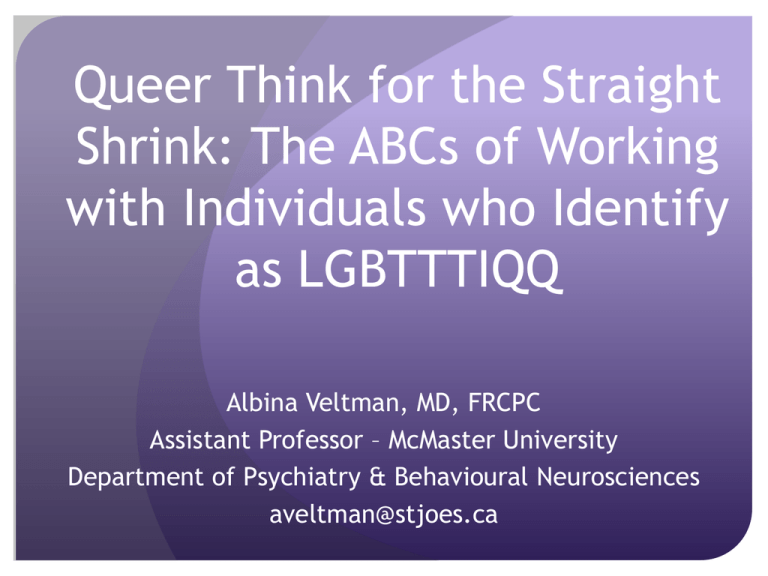
Queer Think for the Straight
Shrink: The ABCs of Working
with Individuals who Identify
as LGBTTTIQQ
Albina Veltman, MD, FRCPC
Assistant Professor – McMaster University
Department of Psychiatry & Behavioural Neurosciences
aveltman@stjoes.ca
Conflicts of Interest
• None to declare
Objectives
• Understand the terminology related to LGBTTTIQQ
communities
• Gain knowledge regarding some of the specific
mental health care needs of LGBTQ individuals
• Understand the barriers in accessing mental health
services
• Gain knowledge regarding how to reduce
healthcare access barriers for LGBTQ individuals
• Outline outcomes of The LGBTQ Community
Wellness Centre of Hamilton’s Mental Health Clinic
The ABCs of LGBTTTIQQ Communities
• Lesbian
• Gay
• Bisexual
• Transgender
• Transsexual
• Two-spirit
• Intersex
• Queer
• Questioning
Other Important Terminology
• MtF, M2F, transwoman
• FtM, F2M, transman
• Cis-gender
• Genderqueer
• Gender Reassignment Surgery/GRS
Other Important Terminology
• Sexual orientation: how one identifies their sexual
attraction and affection, both physical and
emotional
• Gender identity: a person’s deep sense of being
male, female, neither or both
• Ally: a person who is not a member of a specific
group, but who supports that group, challenges
discrimination and oppression of that group, and
explores their own biases
Kinsey Scale
Kinsey, et al., 1948
Other Important Terminology
• Homo/bi/trans-phobia: individual, social and systemic
values, beliefs, attitudes and actions that indicate
hate, discrimination and “othering” of people who do
not conform to socially prescribed sexual/gender
identities and norms
• Heterosexism: the assumption that heterosexuality is
the preferred norm and that most people are
heterosexual
• Heterosexual privilege: Because of heterosexism,
being a heterosexual in our society carries with it
power and privileges
Heterosexism
“When I went to an addiction treatment clinic,
the nurse asked me, ‘What’s your husband’s
name?’ I said, ‘I don’t have a husband’. ‘Okay’,
she then asked, ‘Is it your boyfriend?’ I said, ‘I
have a partner’. She said, ‘What’s his name?’
When it comes to these questions, it’s so
uncomfortable. I don’t make it a big deal myself.
I just said, ‘Her name is Sharon’. But then you
can see their faces changing. Then you feel
uncomfortable for the rest of the questions.”
Kidd, Veltman, et al, 2011
Statistics
•
Vary widely according to definition used
•
Estimates of LGBTQ individuals vary from 2-14% of
the population
•
1 in 30,000 males at birth and 1 in 100,000 females
at birth seek GRS in North America
American Psychiatric Association, 2000
•
1 in 10,000 males at birth and 1 in 30,000 females at
birth seek GRS in Denmark
van Kesteren, 1997
Lack of Education on LGBT Issues
• Median number of hours of education on LGBT issues
= 5 hours
• 54.5% of Canadian schools reported 0 hours of
clinical training in LGBT health!
Obedin-Maliver, J. et. Al., 2011
• Situation at McMaster University– 3 hours in
undergrad, 2 ½ hours during psychiatric residency
Lack of Education on LGBT Issues
Frequency of physician’s response to the statement,
“Adolescent Sexual Orientation should be addressed
more often in the course of training”
Disagree or
strongly disagree
Agree or
strongly agree
Don’t know
Psychiatry
6
94
0
OB/GYN
27
60
13
Internal Medicine
18
71
11
Family Practice
17
79
3
Pediatrics
13
88
0
Emergency Medicine
48
48
5
Total Physicians
20
75
5
Kitts, 2010
Lack of Discussion re: LGBT Status
Frequency in which physicians discuss sexual orientation
while taking a sexual history from a sexually active
adolescent
Unlikely
Sometimes Regularly
Psychiatry
14
50
36
OB/GYN
62
15
23
Internal Medicine
45
17
38
Family Practice
12
39
50
Pediatrics
57
27
17
Emergency Medicine
70
30
0
Total Physicians
42
29
29
Kitts, 2010
Holistic Approach
• LGBTQ people have the same health concerns as
anyone else, as well as some additional risk factors
• Important to engage the whole person, do not treat
patients like a collection of risk factors
• Important to understand that life issues for people
who are LGBTQ are similar to everyone else:
• Work stressors
• Financial issues
• Long Term Relationships
• Parenting
• Aging
Special Considerations in LGBTQ
Mental Health
Increased vulnerability due to:
• Loss of supports/rejection
• Burden of keeping a secret identity
• Bullying/violence
• Discrimination/Heterosexism/Genderism
• Coming out process
• Internalized homophobia
• Pathologization by the medical/psychiatric
community
Institute of Medicine, 2011
Barriers to Accessing Health Services
for LGBTQ Individuals
• Discomfort/fear of disclosing LGBTQ status due
to real or perceived Homo/Bi/Transphobia
• Patient’s own internalized Homo/Bi/Transphobia
• Provider ambivalence/discomfort related to
inadequate education re: LGBTQ issues
• Heterosexist assumptions on forms/interviews
Sears, 2009
Barriers to Accessing Health Services
for LGBTQ Individuals
• “Dual alienation”
• Pathologization of LGBTQ status
• Previous experiences or stories of “corrective or
reparative” therapies
• No opportunity for disclosure – providers not
asking the right questions
Sears, 2009
Dual Alienation
“I’m not really all that accepted in the
mental health patient community because I’m
a lesbian and I’m not accepted in the lesbian
community because I’m a mental health
patient. I don’t feel like I belong anywhere.’’
Kidd, Veltman et al, 2011
Dual Alienation
“The LGBTQ community is already
marginalized. The mental health community
is already marginalized. When you belong to
two marginalized groups, you become that
much further marginalized.”
Kidd, Veltman et al, 2011
Pathologization of the LGB Community
• History of homosexuality in the DSM
Bayer, 1987
• Consideration of sexuality/gender status as part
of illness
• Aversive/reparative therapies (eg.“Pray away
the gay”)
• Expectation of increased rates of psychiatric
diagnoses
Biaggio et al, 2000
Gender Identity Disorder in the DSM:
The Controversy Continues
•
Many transgender activists/individuals want GID to
be removed from the DSM
•
WPATH and CPATH (World/Canadian Professional
Association for Transgender Health) support the
removal of GID from the DSM
•
If not under psychiatry’s umbrella, who will
diagnose/treat? How will individuals receive
treatment they need and want without a diagnosis?
Allison, 2010; Winters & Ehrbar, 2010
Pathologization
“I’ve had several doctors and nurses tell me
that I must be depressed because I’m a
lesbian and I haven’t dealt with that. That’s
bull****. I was a happy, out-and-proud,-in-arelationship, lesbian before I got depressed
for the first time. I don’t think it has anything
to do with my being gay.”
Kidd, Veltman et al, 2011
Dismissiveness/“Neutrality”
• Dismisses the potential importance of sexuality
as a part of the client’s identity
• Doesn’t take into account the experience of the
individual
Willging et al, 2006
Asking the Right Questions
Are you currently dating, sexually active or in a
relationship(s)? Yes □ No □
If yes, is (are) your partner(s):
female □ male □
intersex □ transsexual □
transgender □ two-spirit □ other □ ________
How would you identify your sexual orientation?
straight/heterosexual □ lesbian □ gay □ bisexual □
woman who has sex with women (WSW) □ man who has
sex with men (MSM) □ transensual □ polysexual □
two-spirit □ questioning □ asexual □ autosexual □
unsure □ other □ ________
Do you have concerns related to your sexual orientation, or
do you ever feel awkward about your sexual orientation?
Not at all □ a little □ somewhat □ a lot □ unsure □
ARQ2, 2007
Asking the Right Questions
How would you identify your gender identity?
female □ male □ transsexual □ transgender □
genderqueer □ two-spirit □ FTM □ MTF □ intersex □
questioning □ other □ ________
Do you have concerns related to your gender identity or
do you ever feel awkward about your gender identity?
Not at all □ a little □ somewhat □ a lot □ unsure □
Is your reason for getting help related to any issues
around your sexual orientation or gender identity?
Can you tell me about any particular problems you have
faced because of discrimination based on your sexual
orientation/gender identity?
ARQ2, 2007
Asking the Right Questions
At about what age did you first realize your were _____?
What has it been like for you after coming
out/transitioning to yourself and to others?
How open are you about your sexual orientation/gender
identity? At work? At school? At home? With new
acquaintances?
Tell me about your family. How has your sexual
orientation/gender identity affected your relationship with
your family? Do you have support from your family?
How involved are you in the LGBTTTIQQ communities?
ARQ2, 2007
Mental Health Disparities
• 2-6 times greater lifetime risk of suicide
attempt and/or depression
• Social stigma, prejudice and discrimination
associated with minority sexual orientation
accounts for a significant portion of the
increased risks
King et al, 2008; Haas et al, 2011
Mental Health Disparities
Meta-analysis of 25 international studies
• 4 times risk of suicide attempt in LGB people
• 1.5 times risk of depression or anxiety disorder
in LGB people
• 3 times greater risk of substance use disorder
in lesbian/bisexual women
• 2 times greater risk of depression and panic
disorder in gay/bisexual men
King et al, 2008
Suicide in Transgender People
• 77% have seriously considered suicide
• 50% have seriously considered suicide
because of trans status
• 43% have attempted suicide at some point
TransPULSE, 2010
LGBTQ Youth
• One in seven Canadian high school students
self-identify as LGBTQ (14%)
• 70% of all high school students reported
hearing homophobic remarks every day in
school
• Almost 10% of LGBTQ students reported
having heard homophobic comments from
teachers daily or weekly
Egale Canada, 2011
LGBTQ Youth
• >40% of LGBTQ students report having experienced
sexual harassment in school in the last year
• Three-quarters of LGBTQ students and 95% of trans
students feel unsafe at school (compared to 20% of
heterosexual students)
• Approximately 28% of LGBT youth drop out of high
school because of discomfort or fear in the school
environment
Egale Canada, 2011
Suicide in LGBTQ Youth
• 42% of LGBTQ youth reported thoughts of suicide
at some time, 25% in the past year
• 1/3 of LGBTQ youth report having made a suicide
attempt at some time
• LGBTQ youth are 3-4 times more likely to make a
suicide attempt
Russell & Joyner, 2001
• LGB youth who come from highly rejecting families
are more than 8 times as likely to have attempted
suicide than LGB peers who reported no or low
levels of family rejection
D’Augeill et al, 2005; Ryan et al, 2009
LGBTQ Youth Homelessness
• 22-35% of homeless youth identify as LGBTQ
• Many of these youth have been kicked out of their
home and/or do not feel safe at home
Van Leeuwen et al, 2006
Defining
Care
• LGBT-tolerant
• Aware that LGBT people exist and use services
• LGBT-sensitive
• Aware of, knowledgeable about, and accepting of
LGBT people
• LGBT-affirmative
• Actively promote self-acceptance of an LGBT
identity as a key part of health and recovery
Positive Experiences with Providers
• Can facilitate recovery in general
• Can facilitate process of coming out
• Greatly increases sense of connection and self-worth
• Can be extremely helpful when provider is queer, but not
a necessity
• Importance of linkages with community
“When a nurse shared that she was a lesbian: It made me feel less
ashamed. It was because she is a nurse and she is gay and there is
nothing wrong with that. I didn’t have to be ashamed for being gay.”
Negative Experiences with Providers
• Negative impacts of stigma and lack of
understanding on clinical work:
• Overemphasis on LGBT identity
• Lack of understanding > irrelevant lines of inquiry and focus
• Regarding LGBT as a result of mental illness
• Hinders establishment of rapport/trust
• “There was one doctor who asked me ‘If you have children, how can you be a
lesbian?’”
• Bottom line: Lack of client-centred care
Allies
If you’re not LGBTQ
yourself, become an
ally!
LGBT Affirmative Care
• Evaluate your belief system
• Understand risk factors associated with LGBT
patients
• Advocate for policy changes that are LGBTaffirmative
• Create and maintain a positive office space
Coren, JS et al., 2011; Haas, AP et al., 2011
What constitutes a positive space?
• Inclusive language
• Lack of assumptions
• LGBT posters/pamphlets/signs
• Respect
• Acceptance and celebration of diversity
Treatment Do’s
• Ask all clients about their sexual orientation and gender
identity.
• Be guided by your LGBTQ clients. Listen to what they
say is comfortable for them.
• Acknowledge clients’ significant others and encourage
their participation in treatment.
• Require all clients and staff members to create and
maintain a safe environment for all LGBTQ clients.
• Post a non-discrimination policy in the waiting room
that explicitly includes sexual orientation and gender
identity.
Treatment Do’s
• Use the proper pronouns based on patient’s selfidentity when talking to/about transgender
individuals.
• Allow transgender clients to continue the use of
hormones when they are prescribed. Advocate
for the transgender patient using “street”
hormones to be able to access medically
prescribed hormones.
• Allow transgender patients to use bathrooms
and showers based on their gender selfidentities.
The LGBTQ Community Wellness
Centre of Hamilton (The Well)
Community organization started in 2004
Response to a hate crime against a well-known gay man
in the community
Mostly volunteer-run
Small amount of Trillium Grant funding
Several groups running, including: Lesbian and Bi
Women’s Support, Same-sex partners Planning Parenting,
Trans Peer Support, Queer Youth Group, and Running
Group
The Well Mental Health Clinic
Types of patients seen at the clinic
Sexual
orientation/gender
identity
Number of clients
MTF
FTM
24
12
Lesbian
Bisexual
10
2
Gay
2
The Well Mental Health Clinic
Types of patients seen at the clinic
Primary presenting issue
Number of Clients
Gender identity disorder
14
Major Depressive Disorder
Axis II Disorder
10
9
Adjustment Disorder
Anxiety disorder
7
6
Bipolar Disorder
4
The Well Mental Health Clinic
The Role of Advocacy in Trans Health Care
Type of Advocacy
Number completed
Referral for hormone
treatment
Gender change letter for
Ministry of Transport
20
12
Gender change letter for
5
OHIP
Carry letter for washrooms 16
LGBTQ Youth Resources
www.youthline.ca - 1-800-268-6888 – LGBT Youth line – Toll-free by
youth for youth – Sun-Fri 4:00 – 9:30 pm
www.pflagcanada.ca - Parents and Friends of Lesbians and Gays –
Organization that supports families and friends of LGBTQ individuals.
www.hifyhamilton.com - 905-528-3009 - Health Initiatives for Youth
Hamilton
www.niagarapride.ca - Rainbow Youth Niagara – 905-380-4576
www.rainbowhealthontario.ca – Ontario-wide resource for LGBTQ health
www.thetrevorproject.org – The Trevor Project – Suicide Prevention for
the LGBTQ community
www.itgetsbetter.org - It Gets Better Project – Suicide Prevention Online
Project
Other Web Resources
http://www.MyGSA.ca/OntarioKit - Curriculum, how to start/continue a
GSA/Positive Space group
www.opsta.com - Ontario Positive Space Teachers Association – great
resources available for downloading re: curriculum
www.egale.ca - Every Class in Every School Report, other resources
http://www.camh.net/Publications/Resources_for_Professionals/ARQ2
/arq2.pdf - Asking the Right Questions Manual - helpful resource for
knowing how to ask questions regarding sexuality and gender identity
www.glsen.org – Gay Lesbian and Straight Education Network
Other Web Resources
http://www.gender.org - Gender Education and Advocacy is a U.S.
National organization focused on the needs, issues, and concerns of gender
variant people in human society.
www.2spirits.com - Information about and for Aboriginal two-spirit
individuals.
http://www.wpath.org - The World Professional Association for
Transgender Health is a professional organization devoted to the
understanding and treatment of gender identity disorders.
http://www.isna.org - The Intersex Society of North America is devoted to
systemic change to end shame, secrecy, and unwanted genital surgeries
for people born with an anatomy that someone decided is not standard for
male or female.
Other Web Resources
www.fenwayhealth.org - The Fenway Institute works to make life
healthier for those who identify as LGBTQ, people living with HIV/AIDS,
and the larger community.
http://www.glma.org - The Gay and Lesbian Medical Association exists
to maximize health care for LGBTI individuals.
www.transpulse.ca - The Transpulse Project website contains
information regarding a recent study of health care disparities within
the transgender community.
http://www.sherbourne.on.ca/ - The Sherbourne Health Centre
provides health care to over 500 trans-identified patients. Guidelines
regarding treatment of trans patients are available.
References
Allison, R. (2010). Aligning bodies with minds: The case for medical and surgical
treatment of gender dysphoria. Journal of Gay & Lesbian Mental Health, 14(2), 139–144.
Bayer, R. (1987). Homosexuality and American Psychiatry: The politics of Diagnosis
(revised edition). Princeton, NJ: Princeton University Press.
Bolton, S-L., & Sareen, J.(2011). Sexual Orientation and it relation to mental disorders
and suicide attempts: Findings from a nationally representative sample. The Canadian
Journal of Psychiatry, 56 (1), 35-43.
Coren, JS et al., (2011). Assessing your office for care of lesbian, gay, bisexual, and
transgender patients. The Health Care Manager 30 (1), 66-70.
D’Augelli, A.R., et al., (2005). Predicting the suicide attempts of lesbian, gay, and
bisexual youth. Suicide and Life Threatening Behavior, 35(6), 646–660.
Drescher, J. (2010). Transsexualism, gender identity disorder and the DSM. Journal of Gay
& Lesbian Mental Health, 14(2), 109–122.
References
Haas, AP., et al., (2011). Suicide and Suicide Risk in Lesbian, Gay, Bisexual, and
Transgender Populations: Review and Recommendations. Journal of Homosexuality,
58:10–51.
Kidd, SA. , Veltman, A. , Gately, C. , Chan, K.J. and Cohen, JN.(2011) Lesbian, Gay,
and Transgender Persons with Severe Mental Illness: Negotiating Wellness in the
Context of Multiple Sources of Stigma, American Journal of Psychiatric Rehabilitation,
14: 1, 13 – 39.
King, M., Semlyen, J., Tai, S. S., Killaspy, H., Osborn, D., Popelyuk, D., et al. (2008).
A systematic review of mental disorder, suicide, and deliberate self harm in lesbian,
gay, and bisexual people. BMC Psychiatry, 8: 70.
Kitts, R. (2010). Barriers to Optimal Care between Physicians and Lesbian, Gay,
Bisexual, Transgender, and Questioning Adolescent Patients. Journal of
Homosexuality, 57:730-747.
Obedin-Maliver, J. et al, (2011). Lesbian, Gay, Bisexual, and Transgender–Related
Content in Undergraduate Medical Education. JAMA, 306, (9), 971-977.
Russell, S. T., & Joyner, K. (2001). Adolescent sexual orientation and suicide risk:
Evidence from a national study. American Journal of Public Health, 91(8), 1276–1281.
References
Ryan, C., Huebner, D., Diaz, R., & Sanchez, J. (2009). Family rejection as a predictor of
negative health outcomes in White and Latino LGB young adults. Pediatrics, 123, 346–
352.
van Kesteren, P. J., Asscheman, H., Megens, J. A., & Gooren, L. J. (1997). Mortality and
morbidity in transsexual subjects treated with cross-sex hormones. Clinical
Endocrinology, 47(3), 337–342.
Willging, CE, Salvador, M, Kano, M., (2006). Brief reports: Unequal treatment: mental
health care for sexual and gender minority groups in a rural state. Psychiatric Services,
57 (6): 867-870.
Winters, K., & Ehrbar, R. D. (2010). Beyond conundrum: Strategies for diagnostic harm
reduction. Journal of Gay & Lesbian Mental Health, 14(2), 130–138.
Thank you
• Lisa Jeffs
• D. Dixon
• Dr. Suzanne Mills
• Dr. Christina McDonald
• Dr. Aisha James
• Dr. Linda Plowright
Queer Think for the Straight
Shrink: The ABCs of Working
with Individuals who Identify
as LGBTTTIQQ
“It is not our differences that divide us. It is our inability to
recognize, accept, and celebrate those differences.”
Audre Lorde

